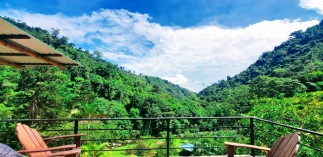Welcome back, birding enthusiasts, to our Costa Rican retreat nestled amidst the verdant mountains! Today, we turn our binoculars to a vibrant resident of the forest canopy, the Rufous-winged Tanager (Tangara lavinia). This little ball of color is sure to add a touch of the tropics to your birdwatching repertoire.
A Dazzling Display of Feathers
The Rufous-winged Tanager lives up to its name with a plumage that showcases a delightful contrast. Males boast a deeper emerald green body, making them a true gem of the rainforest. This emerald sheen gives way to a stunning splash of rufous (a reddish-brown color) across their heads and wings. Their backs are adorned with a sunny yellow, adding another layer of vibrancy to their appearance.
Females, while lacking the male’s emerald intensity, are no less beautiful. They sport a duller yellow-green plumage, but their rufous wings remain prominent, offering a key identification feature.
Habitat and Habits
These tanagers are primarily found in the subtropical and tropical moist lowland forests of Central America. Here at our Costa Rican retreat, you have a fantastic chance of spotting them flitting about the lush canopy. But don’t be surprised if you encounter them in heavily degraded former forests as well – they seem to be adaptable creatures.
The Rufous-winged Tanager is a social butterfly (or perhaps more accurately, a social tanager) of the avian world. They are often seen in pairs, flitting through the leaves, but they also readily join mixed-species flocks. Keep your ears peeled for their vocalizations – they are known to emit high-pitched whistles and buzzing trills.
A Look at Their Life
These tanagers are non-migratory, meaning they spend their entire lives within the same general territory. They are insectivores, primarily feeding on a variety of insects and other small invertebrates they glean from the leaves and branches.
The Rufous-winged Tanager builds its cup-shaped nest high up in trees. The female lays two to three eggs, which are incubated for about two weeks. Both parents take turns caring for the chicks until they fledge, which takes roughly 14 days.
Spotting the Rufous-Winged Tanager
So, how can you increase your chances of encountering this dazzling bird on your Costa Rican retreat? Here are some tips:
- Head for the Canopy: Look up! Rufous-winged Tanagers tend to stay high in the forest canopy, so pack binoculars with good zoom capabilities.
- Follow the Mixed Flocks: These tanagers are often part of mixed-species flocks, so keep an eye out for a flurry of activity in the trees.
- Listen for Their Calls: Their high-pitched whistles and buzzing trills can serve as a clue to their location.
- Patience is Key: Birding requires a bit of patience. Sit quietly near promising areas like forest edges or fruiting trees and wait for them to emerge.
With a little dedication and these tips in mind, you might just be rewarded with a glimpse of the Rufous-winged Tanager, a dazzling splash of color amidst the Costa Rican rainforest.
For more information, please view our comprehensive guide about the birds of Costa Rica







